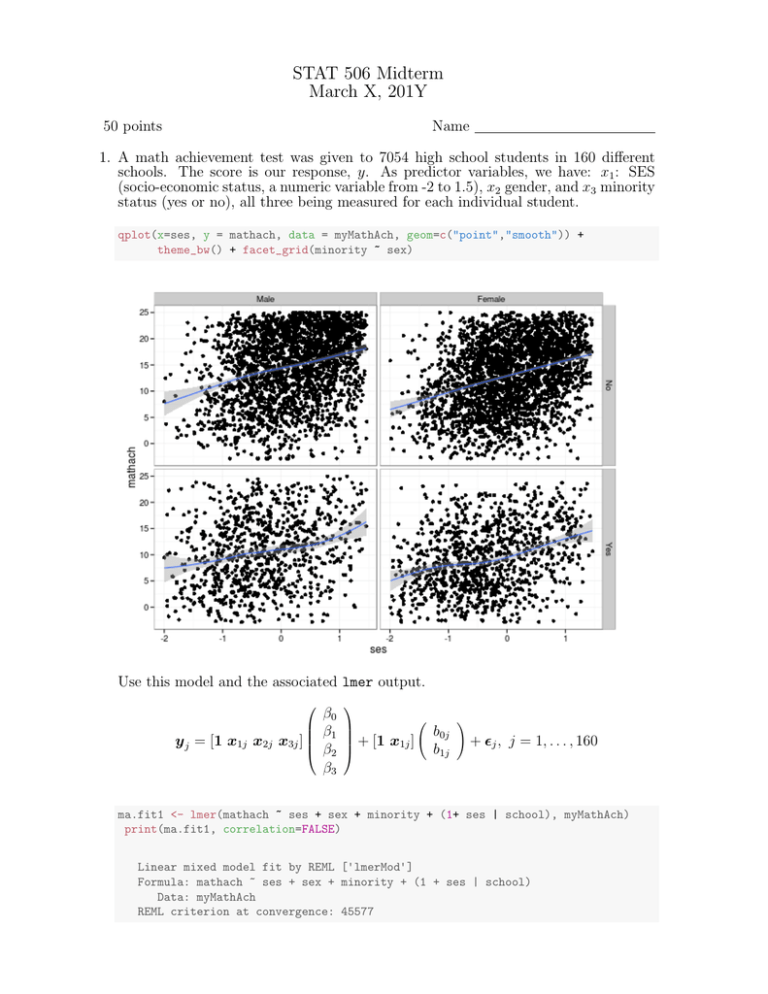STAT 506 Midterm March X, 201Y
advertisement

STAT 506 Midterm March X, 201Y 50 points Name 1. A math achievement test was given to 7054 high school students in 160 different schools. The score is our response, y. As predictor variables, we have: x1 : SES (socio-economic status, a numeric variable from -2 to 1.5), x2 gender, and x3 minority status (yes or no), all three being measured for each individual student. qplot(x=ses, y = mathach, data = myMathAch, geom=c("point","smooth")) + theme_bw() + facet_grid(minority ~ sex) Use this model and the associated lmer output. y j = [1 x1j x2j x3j ] β0 β1 β2 β3 + [1 x1j ] b0j b1j ! + j , j = 1, . . . , 160 ma.fit1 <- lmer(mathach ~ ses + sex + minority + (1+ ses | school), myMathAch) print(ma.fit1, correlation=FALSE) Linear mixed model fit by REML ['lmerMod'] Formula: mathach ~ ses + sex + minority + (1 + ses | school) Data: myMathAch REML criterion at convergence: 45577 Exam 1 Stat 506 Page 2 Random effects: Groups Name Std.Dev. Corr school (Intercept) 1.914 ses 0.574 -0.41 Residual 5.994 Number of obs: 7054, groups: school, 160 Fixed Effects: (Intercept) ses sexFemale minorityYes 14.16 2.11 -1.20 -2.99 (a) Interpret estimated population effects for ses, minority, and sex (skip the intercept). Give the estimated size, sign, and the strength of evidence for each being nonzero. Explain in terms of this situation, not just in general platitudes. (10pts) (b) Write out the estimated distribution of b0j b1j ! . Plug in the estimates from the output. (5 pts) (c) Ses appears in the model twice. Explain the difference in interpretation between the two ses outputs. (4 pts) (d) Let y 1 be the vector of 15 math achievement scores for the first school (labeled 8367 below). xtable(head(ranef(ma.fit1)[["school"]])) 8367 8854 4458 5762 6990 5815 (Intercept) -4.98 -4.99 -2.38 -2.83 -2.84 -2.42 ses 0.46 0.65 0.23 0.36 0.14 0.37 i. Write down its predicted mean vector (based on x1j , x2j , x3j which you don’t have access to for this exam, just use them as symbols) plugging in the estimates from the output. (5 pts) ii. What is the estimated variance-covariance of y 1 ? (Hint: avoid rewriting things you already explained above by giving them a label above and just using that here.) (5 pts) (e) If we did the same analysis in SAS PROC MIXED: i. How would the fixed effects SAS reports differ from those of R? (3 pts) ii. How would the random effects SAS reports differ from those of R? (3 pts) (f) Two other models were considered. Explain how they differ and which you prefer based on the following output. (6 pts) Exam 1 Stat 506 Page 3 ma.fit2 <- lmer(mathach ~ ses * minority + sex + (1+ ses | school), myMathAch) ma.fit3 <- lmer(mathach ~ ses * minority + ses * sex + (1+ ses | school), myMath xtable(AIC(ma.fit1,ma.fit2,ma.fit3)) ma.fit1 ma.fit2 ma.fit3 df AIC 8.00 45593.02 9.00 45580.31 10.00 45579.78 2. Consider a comparison of two curricula (A and B) for teaching intro stats to college students. Students will register for a section of the class which fits their schedule not knowing if the section will be taught using the A or the B curriculum. (a) How will this design allow for causal inference? Explain any necessary assumptions. (5 pts) (b) Curriculum B requires two 75 minute meeting times each week, but A will be taught in three 50 minute sessions. Discuss in terms of imbalance and/or overlap. What further assumption(s) is(are) required? (4 pts)




